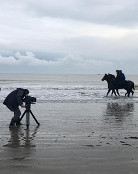Donn's Articles » Strategic Marketing Group Report
Strategic Marketing Group Report
There is some good stuff in the Strategic Marketing Group report published last week, which is as it should be, given the exhaustiveness of the consultative process that presaged it.
Like the recommendation for a two-tier fixture list. Under the recommendation, race days would be defined as either Premier or Standard. Standard days would essentially be those largely ordinary days that are the lifeblood of the Irish racing industry, industry days for all the world, the midweek afternoon fixtures that go ahead when most sane people are at work, which provide owners and trainers and jockeys with Opportunities To Race and which give Irish racing its soul.
The goal with Standard days would be the reduction of costs, the provision of essential facilities only, a scaled-down Tote service, cheaper racecard production, a significant reduction in, or complete cessation of, marketing spend. The theory is that, as a consequence, more resources could be devoted to the Premier days, to the promotion thereof and the provision of services thereon, thus enhancing the racegoing experience. It makes sense, concentrate your resources – scarce as they are – on the big meetings and the festivals, push the open doors, pick the low-hanging fruit, encourage people to go racing when they are free to go racing. It is not by accident that the Japan Racing Association race only on weekends and on national holidays.
The net effect would inevitably be the widening of the moat that exists between the big days and the small days, and that is not going to make everybody happy, but isn’t that the way the sporting world is going (Premier League v Football League, Heineken Cup v Magners League), and don’t the big racing days have to compete with the big GAA and the big football and the big rugby days, not with the small racing days? And is it any harm to present a distinct demarcation between a Guineas Sunday and an upside-down handicap hurdle Thursday?
The disappointment of the report is that it does not dig deeply enough. There was never an expectation that it would be Irish racing’s panacea, but there was an expectation that it would have teeth, that it would be the forerunner to the tough decisions that need to be made now for the good of Irish racing. Perhaps it will be. Perhaps the tough decisions will follow now. For now, however, it reads more like a wish list than a strategy document.
The difficulty with Irish racing is that it has evolved with factional interests. In a sense, that is also the charm of it, that is what gives it its uniqueness, its place in Irish culture, but it means that any proposed fundamental change will almost certainly be resisted by at least one faction. That makes change difficult. To compare Irish racing with Japanese racing is unfair, not only because the Japan Racing Association has direct access to all monies that are legally bet on Japanese racing (the JRA actually contributes to the National Treasury, not the other way around), but also because the JRA has complete control over all aspects of Japanese racing.
That said, as the primary custodians of Irish racing, HRI are best positioned to take a strategic view, a long-term view, steer the good ship racing in the right general direction, even if all stakeholders are not in favour of the charted route. The determinant should be the betterment of Irish racing, not the appeasement of stakeholders. These are choppy waters. As such, the establishment of the Strategic Marketing Group, and the recognition of the need for radical action that that implied, was a significant step forward.
However, there is much in the SMG’s report that is superfluous. Window dressing. To include as a recommendation that the flat season should end with the November Handicap at Leopardstown and not in the depths of winter when the National Hunt season is in full swing – something that most people have been calling for long before Joseph O’Brien and Gary Carroll and Ben Curtis put their six collective shivering hands around the apprentices’ trophy at Dundalk last December – is hardly a strategic recommendation. Nor is the recommendation to trial the use of shorter intervals between races, despite the column inches that that one has since generated.
And it is a little mystifying that the recommendation to fix the start date for the Punchestown Festival (the last Tuesday in April, by the way) gets more explanatory space than the recommendation that HRI steps up its work with schools and colleges, something that should be at the very core of the objective to “increase the level of those interested in racing from 22% to 37% by 2015”, and something that HRI are ideally positioned to do.
Of course, the elephant in the room is the on-course betting market, the desire to reconcile the need to ensure that racegoing punters are not disadvantaged by being at the races, instead of at home in front of the television with their laptops, with the need to nurture a healthy and a vibrant on-course betting ring. Disappointingly, that one is a kick to touch.
As a report, it is a step in the right direction, no question. But it is only a small step. The effectiveness or otherwise of the entire process will be determined by the strategic decisions that are implemented, not in the window dressing that is employed. These are uncharted waters.
© The Racing Post, 17th May 2011


 Follow Donn
Follow Donn